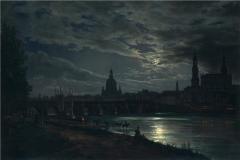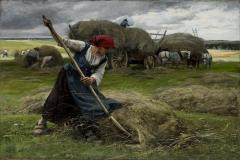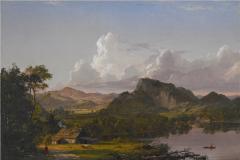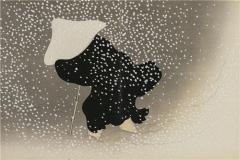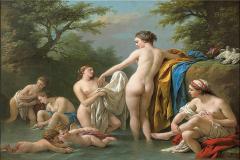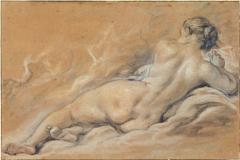Choosing a Composition
Pastel Painting Seascape Demonstration
There were two inspirations for this step-by-step pastel painting: first the visit to the dramatic coastline at Tsitsikamma, on South Africa's Garden Route (see reference photos), and second the acquisition of a set of Unison turquoise pastels.
Unison pastels have become my firm favorites, the range of colors are perfect for both landscapes and portraiture, and they have a wonderful softness coupled with a degree of strength that softer pastels usually don't achieve. (See: Which are the Best Pastel Brands?)
I finally decided on the little inlet shown in the photo, at high tide, for my composition. I liked the strong angle the rocks made to the horizon, and the sweep the waves made as they came in.
The colors used for this seascape, including the Unison turquoise set were as follows.
For the sea:
Turquoise (Unison turquoise 1, 2, 4, 5, 6)
Light violet-blue (Unison Blue Violet 15)
Dark blue, almost a Prussian blue (Unison Additional 49)
For the surf:
White (Unison white)
Very pale blue-white (Unison Light 14)
For the rocks:
Dark earth green, or a dark Hooker's green (Unison Additional 37)
Pale light earth green (Unison Green 4)
Light burnt sienna (Unison Brown Earth 10)
Medium burnt sienna (Unison Brown Earth 11) – roughly the same color as the paper
Very Dark brown (Unison Brown Earth 24)
Light neutral gray, Unison Additional 25
For the sky and reflected color in the sea:
Medium Ultramarine blue, Unison Blue Violet 10
Dark Ultramarine blue, Blue Violet 12
Light blue-gray, Unison Grey 11
Light neutral gray, Unison Additional 25
The paper used was a 'orange' Fabriano Tiziano which echoed the warmth of the sand/shingle beach and the lichen on the rocks.
Setting the Focus for the Painting
Pastel Painting Step-by-Step Demonstration: Seascape
Once the general outline had been drawn with a light-colored pastel pencil, I identified the two main characteristics of the painting: the vibrancy of the surf as it entered the inlet, and the striking regularity of the rocks. I then determined the tonal range I would use in the painting: the surf represented by a light turquoise and the rocks by the darkest brown.
Choosing the is an important step in creating a painting. Decide what you want the audience to be most taken with -- it's the part that you will inevitably spend most time on -- and which you expect a viewer to look at most intensely.
I liked the awkward juxtaposition of the straight lines of the rock outcrop and the curving wave fronts expressed by the boundaries of the turquoise block. I also decided that the main highlight would be the furthest line of surf, along the back of the block, which would be breaking quite dramatically.
Blocking In Color
Pastel Painting Step-by-Step Demonstration: Seascape
The next stage was to block in the iconic colors of the composition, using the average tone for each section. The only exception here was the horizon line of the sea for which I used an under layer of blue-violet, knowing that this would ultimately be very dark.
I emphasized the linearity of the rock outcrops by placing a much lighter tone between the dark brown lines, and specified the effect of shallow water and reflected sky in the inlet with a darker and intermediate tone turquoise. The remainder of the sea was filled in with a dark turquoise, and the sky with a medium ultramarine blue.
Adding Additional Color
Pastel Painting Step-by-Step Demonstration: Seascape.
It was now time to extend the range of color used on the painting. On the rocks, reinforcing the linearity, lines of dark and light earth green, and earth brown were added.
A less pale turquoise was added to the edges of the central block, filling in the various tidal pools in the rock outcrops. A small amount of dark ultramarine and the darkest turquoise were added to the sea in the background. This was applied in relatively short lines parallel to the horizon, and getting closer together with distance.
Blending the Pastel Colors
I decided that blending the sky and sea, but not the rock outcrops, would create a tension between the two and encourage the viewer's eye to move between them. The sky has additional blue-gray and light gray added and then blended to crate a fairly homogeneous bar. It's cloudless, but faintly hazy in the distance.
The sea behind the surf has been blended by running my finger from left to right parallel to the horizon line, this created a streaky effect which echoes distant waves. Additional lines of dark ultramarine and turquoise were added and very lightly blended in to create a feeling of wave peaks and troughs.
The surf was blended with a circular motion to give a very smooth transition between the two light turquoise tones. This will act as an under layer for further work to create irregularities, pockets of clear water and surrounding foam.
The shallow water in the inlet was once again blended parallel to the horizon, it was a coincidence that the waves in this area had that orientation, and one which worked well for the composition – echoing the distant sea and highlighting what would be the chaotic strength of the surf.
Adding the Waves to the Painting
Pastel Painting Step-by-Step Demonstration: Seascape
The waves were added at the front and back of the surf, and across the shallow water, using a very pale blue and white pastel. The two tones allowed the creation of depth and texture in the wave, and a slight circular motion helps pull the eye along the waves' peak.
Surf Detail
Pastel Painting Step-by-Step Demonstration: Seascape
The area of surf between the two main waves was covered by a constantly moving melange of foam. The pale blue and white pastel were used in conjunction with the lightest turquoise pastel to give an illusion of this. A hint of dark turquoise was added in a couple of places along the front of the waves to enhance the feeling of depth and structure.
Shadow was also added to the water on the leeward side of the lone rock outcrop out in the surf.
Finishing the Rocks
Pastel Painting Step-by-Step Demonstration: Seascape
The rock outcrops were further enhanced with parallel lines from the small set of colors previously used, but the overall appearance lacked definition. Small check marks were added in a neutral gray, which echoed the color used in the sky, and represented those (mist dampened) edges which caught the light and broke up the smooth run of rock.
When viewed close up, they look almost random, but from a distance the rock outcrop now looks slightly fragmented and worn.
Final Touches
Pastel Painting Step-by-Step Demonstration: Seascape
The last stage of a pastel painting is to add a few touches of intensely light or dark color, which picks out detail and helps move the viewer's eye around the composition. The horizon line was added using a very dark, almost Prussian, blue. A hint of spray was added with white coming over the top of the rock outcrop to the right, and a few dark shadow lines were added to the rocks.
It's now time to take a step back and give the painting a critical look (and try turning it upside down to see if there is anything glaringly wrong with the composition).
Sitting Back and Contemplating the Painting
Pastel Painting Step-by-Step Demonstration: Seascape
All the painting needed was a gentle knock on the back to remove loose pastel dust and light spray of fixative (it was going to be transported). I then left it in-situ so that I could come back after a while and check that it captured the essence of the scene I had selected.

